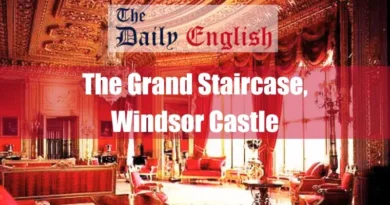The Palace in Woodstock, Oxfordshire, is one of the finest examples of a walled garden in the United Kingdom. Built in the 18th century, it is an iconic symbol of English Baroque architecture and a UNESCO World Heritage Site. Two thousand one hundred acres of parkland, formal gardens, and a walled garden restored to its former glory surround the Palace. This article will explore the history and features of the walled garden at Blenheim Palace.
Blenheim Palace is home to the Dukes of Marlborough, and the current resident is Charles James Spencer-Churchill, the 12th Duke of Marlborough. He inherited the title in 2014 after his father’s passing.
It’s interesting to note that while the Duke holds the title, the palace is actually under the trustees’ control.
Oxford Mail
I. The History of the Walled Garden at Blenheim Palace
Lancelot ‘Capability’ Brown, the renowned English landscape architect, designed the walled garden at Blenheim Palace in the 1760s. The garden aimed to provide fresh fruits and vegetables for the Palace’s residents and guests while enhancing the estate’s beauty. The garden’s builders used locally quarried stone to construct the walls west of the Palace.
The garden underwent many changes over the years. In the late 19th century, people used it as a market garden, and in the early 20th century, they transformed it into a formal garden. During World War II, they used it to grow vegetables to support the war effort. However, in the 1970s, people abandoned the garden and left it to decay.
In 1990, the Blenheim Palace restoration team began restoring the walled garden to its former glory. The process took over a decade to complete and included rebuilding the walls, planting new fruit trees and vegetables, and creating new pathways and flower borders.
II. The Design of the Walled Garden
Blenheim Palace’s walled garden spans around 4 acres and features multiple sections. Its design follows a geometric plan, with symmetrical borders and paths that radiate from a central point. The walls surrounding the garden are approximately 10 feet high and shelter the plants and trees.
The garden is divided into several sections, including the Kitchen Garden, the Herb Garden, the Rose Garden, the Water Garden, and the Secret Garden. The Kitchen Garden is the most extensive, including raised beds, fruit trees, and vegetables. The Herb Garden is located in the southwest corner of the garden and consists of various herbs and medicinal plants.
The garden has the Rose Garden, located in the southeast corner, which boasts a collection of over 100 different rose varieties. The Water Garden, located in the centre, features a large pond surrounded by water-loving plants. Lastly, the Secret Garden, a quiet and secluded area in the northwest corner of the garden, has a small pond, a gazebo, and various flowers and shrubs.
III. The Features of the Walled Garden
The walled garden at Blenheim Palace is home to various plants and trees, including fruits, vegetables, herbs, and flowers. The garden boasts a collection of heritage fruit trees, with over 80 varieties of apples, pears, and plums. Gardeners train the trees in various shapes, such as espaliers and cordons, to maximize space use and create exciting wall patterns.
Gardeners grow vegetables in raised beds, including tomatoes, cucumbers, lettuce, and beans. Each year, gardeners rotate the vegetables to prevent soil-borne diseases and to maximize the use of nutrients in the soil.
The Herb Garden has various herbs and medicinal plants, such as lavender, thyme, mint, and chamomile. Authorities use the herbs in the Palace’s kitchen and for medicinal purposes.
IV. History of the Walled Garden
The walled garden at Blenheim Palace was initially built in the early 18th century as a kitchen garden to provide fresh produce for the Palace’s kitchens. In the 20th century, people stopped using the garden, but in the 1990s, they restored it to its former glory.
Today, a team of expert gardeners maintains the garden, who use traditional techniques to cultivate plants and trees.
V. Visiting the Walled Garden
Now that the walled garden is open, you can access it through a gate near the Palace’s East Courtyard. Visitors can explore the garden and learn about the different plants and trees from information boards located throughout it.
The garden also hosts various events throughout the year, such as gardening workshops, food festivals, and guided tours.
VI.Benefits of a Walled Garden
Walled gardens offer a range of benefits, both practical and aesthetic. The walls provide shelter and protection from the elements, creating a microclimate that allows plants to thrive. The walls also offer a vertical growing space, allowing more plants to grow in a smaller area.
Walled gardens offer practical benefits as well as aesthetic appeal. The trained fruit trees and neat rows of vegetables and herbs create a symmetrical and orderly appearance that is calming and pleasing to the eye.
Also, read What Does Buckingham Palace Look Like?
VII. Take Away
In summary, Blenheim Palace in Oxfordshire, UK, is a UNESCO World Heritage Site and an unforgettable example of English Baroque architecture. Two thousand one hundred acres of parkland and gardens surround it, including a walled garden designed by Lancelot ‘Capability’ Brown in the 1760s. The garden underwent many changes over the years, and the Blenheim Palace restoration team restored it to its former glory in the 1990s. It encompasses approximately 4 acres and is divided into several sections, such as the kitchen garden, the herb garden, the rose garden, the water garden, and the secret garden. It features a variety of plants and trees, including heritage fruit trees, vegetables, herbs, and flowers. The garden is open to the public and offers practical and aesthetic benefits, including a microclimate for plant growth and a pleasing, symmetrical appearance.
VIII. Answers to FAQs about Blenheim Palace Walled Garden
1. What is the Blenheim Palace Walled Garden?
The Blenheim Palace Walled Garden is a large, historical garden located within the Palace estate in Woodstock, Oxfordshire, England. It covers approximately four acres and is surrounded by a brick wall dating back to the early 18th century.
2. When is the Blenheim Palace Walled Garden open?
Blenheim Palace Walled Garden opening times may vary depending on the season and specific events. We recommend checking the official website of Blenheim Palace for the latest information.
3. Is there an admission fee to enter the Blenheim Palace Walled Garden?
There is an entry fee to enter the Blenheim Palace Walled Garden. The admission fee may vary depending on the season and specific events. We recommend checking the official website of Blenheim Palace for the latest information on admission fees.
4. What can visitors see in the Blenheim Palace Walled Garden?
The Blenheim Palace Walled Garden features a variety of garden designs and plant collections, including a rose garden, herbaceous borders, a water garden, and a Mediterranean garden. Several greenhouses within the garden display alluring plants and flowers.
5. Are guided tours available in the Blenheim Palace Walled Garden?
Guided tours may be available in the Blenheim Palace Walled Garden. Still, We recommend checking the official website of Blenheim Palace for the latest information on admission fees.
6. Can visitors bring food and drinks into the Blenheim Palace Walled Garden?
Visitors can bring their food and drinks into the Blenheim Palace Walled Garden. Still, there are also several cafes and restaurants within the Palace estate that offer a variety of food and drink options.
7. Is the Blenheim Palace Walled Garden wheelchair accessible?
The Blenheim Palace Walled Garden is wheelchair accessible, but some garden areas may be challenging for visitors with mobility issues. We recommend contacting the Palace team for specific information on accessibility within the garden.










Comments are closed.